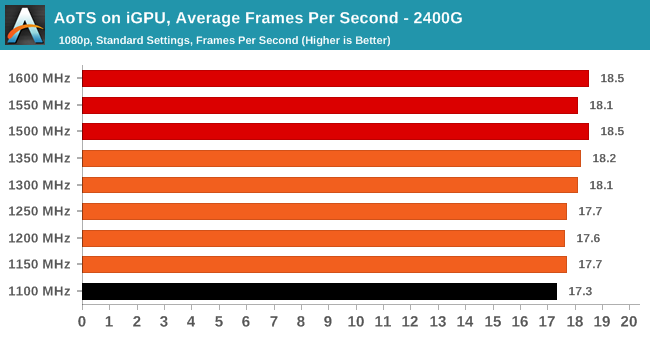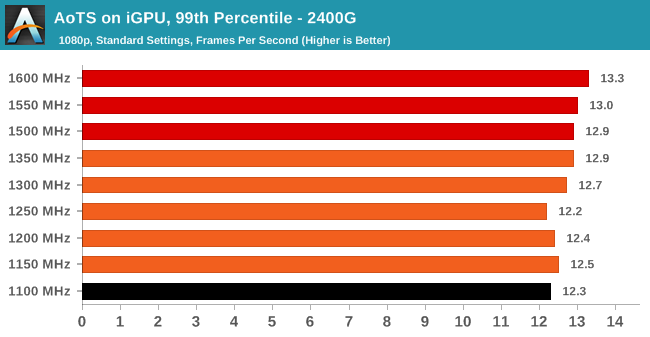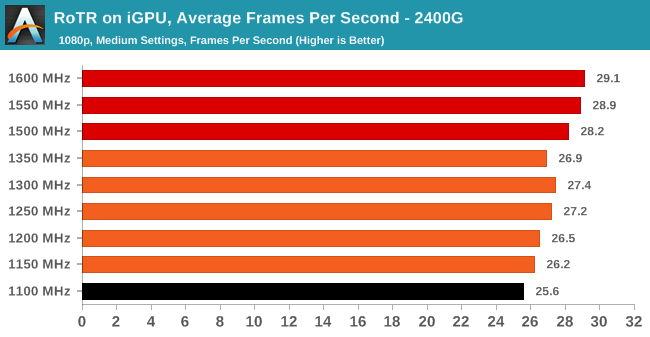AMD Ryzen 5 2400G and Ryzen 3 2200G Integrated Graphics Frequency Scaling
by Gavin Bonshor on September 28, 2018 12:30 PM EST- Posted in
- CPUs
- AMD
- GPUs
- Overclocking
- Zen
- APU
- Vega
- Ryzen
- Ryzen 3 2200G
- Ryzen 5 2400G
Ryzen 5 2400G Integrated Graphics Gaming Performance
As mentioned in the introduction, we overclocked both APUs from 1100 MHz to 1600 MHz in 50 MHz increments. With our gaming tests, we’re primarily concerned with the most common options associated with gaming including resolution; while the Ryzen APUs are marketed for 720p gaming, and while resolutions such as 2160p and 1440p are out of reach purely for performance reasons, we have opted to use moderate settings at 1080p for our testing. As also stated, frequencies between 1400 MHz and 1500 MHz have been omitted due to instability issues relating to a potential issue which we have reached out to AMD for; we will update when AMD respond to us regarding this.
Civilization 6
First up in our APU gaming tests is Civilization 6. Originally penned by Sid Meier and his team, the Civilzation series of turn-based strategy games are a cult classic, and many an excuse for an all-nighter trying to get Gandhi to declare war on you due to an integer underflow.
Truth be told I never actually played the first version, but every edition from the second to the sixth, including the fourth as voiced by the late Leonard Nimoy, it a game that is easy to pick up, but hard to master.


The 2400G saw a modest bump of around 8% in total from the 1100 MHz to 1600 MHz. The 99th percentile frames are also consistent, but both did throw up an anomaly at 1250 MHz, which is actually the default iGPU frequency of the 2400G.
Ashes of the Singularity (DX12)
Seen as the holy child of DX12, Ashes of the Singularity (AoTS, or just Ashes) has been the first title to actively go and explore as many of the DX12 features as it possibly can. Stardock, the developer behind the Nitrous engine which powers the game, has ensured that the real-time strategy title takes advantage of multiple cores and multiple graphics cards, in as many configurations as possible.


Ashes of the Singularity gave an improvement of 8.5% on average frame rates when going from 1100 MHz to 1600 MHz on the Vega 11 iGPU. The 99th percentile also increased around 8% when going from bottom to top, albeit a little shakey at the default iGPU clock of the 2400G.
Rise Of The Tomb Raider (DX12)
Rise of the Tomb Raider (RoTR), developed by Crystal Dynamics, and the sequel to the popular Tomb Raider which was loved for its automated benchmark mode. But don’t let that fool you: the benchmark mode in RoTR is very much different this time around. Visually, the previous Tomb Raider pushed realism to the limits with features such as TressFX, and the new RoTR goes one stage further when it comes to graphics fidelity.
This leads to an interesting set of requirements in hardware: some sections of the game are typically GPU limited, whereas others with a lot of long-range physics can be CPU limited, depending on how the driver can translate the DirectX 12 workload.


The 2400G experienced a consistent improvement as the iGPU was overclocked at each 50 MHz increment with a 13.6% gain in average frames and 12.2% in the 99th percentile from 1100 MHz to 1600 MHz.













49 Comments
View All Comments
Lolimaster - Saturday, September 29, 2018 - link
There was an issue on the APU's were at certain frequencies the clock rate would jump around giving you nasty minimun (shown on many early reviews) and then after a certain threshold, the clock will not jump around like crazy, consistently beating the GT1030 at almost any scenario.ipkh - Friday, September 28, 2018 - link
So how about a Memory plus GPU overclock since those 2 combined would make the most difference.lightningz71 - Saturday, September 29, 2018 - link
Buildazoid showed that significant overclock on both the iGPU and the RAM was quite difficult. The iGPU reacted negatively to lower SOC voltage whereas the memory controller disliked higher SOC voltages. The happy medium seemed to be an iGPU at 1600mhz and running the ram at 3200-3400 mhz with the tightest possible timings. Leave the CPU cores at stock to maximize package power and thermal budget for the iGPU.The_Assimilator - Friday, September 28, 2018 - link
Anyone who knows discrete Vega knows it runs hungry and hot at stock frequencies and even worse when overclocked, but is far better behaved when underclocked and/or undervolted. Hence why these Vega iGPUs have so much OC headroom: they're deliberately being run slow in order to hit an acceptable power/heat target.Given that, the omission of power usage and temperature data from this review is glaring, to say the least.
jensend - Saturday, September 29, 2018 - link
I agree that 'overclocking scaling' reviews that don't show how power and temperature scale are failures. I wouldn't overclock the 2400G for tiny gains and large power/temperature/etc drawbacks.The one interesting conclusion that can be drawn from this piece is that the 2400G's shader etc performance at stock is high enough that at 1080p the bottlenecks are generally elsewhere (esp memory), while that's not as true of the 2200G. (We already kind of knew that from the memory scaling article.)
Nagorak - Saturday, September 29, 2018 - link
I agree, just posted the same myself.Lolimaster - Saturday, September 29, 2018 - link
Still the best reviewer for APU's, specailly OCing scaling and different resolution is techepiphany on youtube, shame on anandtech, they can't even do a proper review for an APU, just a lazy thing.Nagorak - Saturday, September 29, 2018 - link
I kind of feel like this is incomplete without some comparison of power use and heat generation. Maybe not at every frequency but it would be nice to see stock vs max OC at least. Based on the results with Vega GPUs it seems likely that efficiency craters as you go higher. It would be nice to know at least.neblogai - Saturday, September 29, 2018 - link
~50W higher power use is usually not an issue if total system power use is ~150W. But it would be useful to look at it from the point of motherboard SOC VRM ability. Raven Ridge chips are a budget option, so are usually used with cheaper B350 motherboards; however, those often do not have good SOC VRMs(and radiator on them) for extra power overclocked Vega iGPU consumes.notashill - Saturday, September 29, 2018 - link
The other big practical concern for budget builds is the need to spend more money on cooling. The cooler used in this review costs more than the 2400G so it would be totally nonsensical to actually use. Do they actually need crazy cooling to hit these overclocks, or is something like a $30 212 EVO enough?